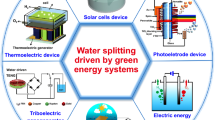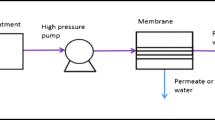Abstract
The current work is about analysis and multi-objective optimization (MOO) of weir-type solar still systems equipped with phase change material (PCM) regarding the exergetic and economic performance. To do so, the energetic and exergetic modeling of the suggested system is conducted then the substantial economic factors is applied to obtain the total cost rate of the considered SSDS. The total exergetic efficiency and total annual cost (TAC) is considered objective functions. Four parameters include mass of the PCM (mPCM), inlet brine water flow rate (\( {\dot{m}}_{\mathrm{f}} \)), gap distance (d), and insulation width (xins) is chosen as decision variables. Moreover, a genetic algorithm–based MOO was applied to find the optimum states of evaluated solar still unit. The outputs represented that increasing the brine feed water mass flow rate does not affect the TAC while decreasing distilled water production rate. The scattered distribution of optimum states infers that the optimum value of PCM mass is about 1 kg. In addition, applied MOO reveals that with optimization of the studied system, the exergy efficiency increases about 1.47% and the annual distilled water increases 4.35% compared with the non-optimized system. The suggested system is capable to produce fresh water in remote areas without any pollution as well as in a low cost rate.















Similar content being viewed by others
References
Abu-arabi M et al (2018) Theoretical investigation of solar desalination with solar still having phase change material and connected to a solar collector. Desalination 448(June):60–68
Al-harahsheh M et al (2018) Solar desalination using solar still enhanced by external solar collector and PCM. Appl Therm Eng 128:1030–1040
Arunkumar T et al (2012) An experimental study on a hemispherical solar still. Desalination 286:342–348
Bait O (2019) Exergy, environ–economic and economic analyses of a tubular solar water heater assisted solar still. J Clean Prod 212:630–646
Cheng W, Huo Y, Nian Y (2019) Performance of solar still using shape-stabilized PCM : experimental and theoretical investigation. Desalination 455(December 2018):89–99
Dashtban M, Tabrizi FF (2011) Thermal analysis of a weir-type cascade solar still integrated with PCM storage. Desalination 279(1–3):415–422
Delyannis E (2003) Historic background of desalination and renewable energies. Sol Energy 75(5):357–366
Dincer, I. & Rosen, M.A., 2000. Exergy,
Duffie JA, Beckman WA (2013) Solar engineering of thermal processes. Wiley
Faegh M, Behshad M (2017) Experimental investigation of a solar still equipped with an external heat storage system using phase change materials and heat pipes, vol 409, pp 128–135
Feilizadeh M et al (2017) Optimization of geometrical dimensions of single-slope basin-type solar stills. Desalination 424(December 2016):159–168
Kabeel AE (2009) Performance of solar still with a concave wick evaporation surface. Energy 34(10):1504–1509
Kabeel AE, Abdelgaied M (2016) Improving the performance of solar still by using PCM as a thermal storage medium under Egyptian conditions. DES 383:22–28
Kabeel AE, Abdelgaied M, Mahgoub M (2016) The performance of a modi fi ed solar still using hot air injection and PCM. DES 379:102–107
Kabeel AE et al (2017) Modified pyramid solar still with v-corrugated absorber plate and PCM as a thermal storage medium. J Clean Prod
Kabeel AE, El-Samadony YAF, El-Maghlany WM (2018) Comparative study on the solar still performance utilizing different PCM. Desalination 432(November 2017):89–96
Kumar S, Tiwari GN (1996) Estimation of convective mass transfer in solar distillation systems. Sol Energy 57(6):459–464
Morcos VH (1994) Optimum tilt angle and orientation for solar collectors in Assiut, Egypt. Renew Energy 4(3):291–298
Ranjan KR, Kaushik SC, Panwar NL (2016) Energy and exergy analysis of passive solar distillation systems. Int J Low-Carbon Technol 11(2):211–221
Rashidi S, Bovand M, Esfahani JA (2016) Optimization of partitioning inside a single slope solar still for performance improvement. Desalination 395:79–91
Rashidi S et al (2018) Steps optimization and productivity enhancement in a nanofluid cascade solar still. Renew Energy 118:536–545
Sarhaddi F et al (2017) Comparative study of two weir type cascade solar stills with and without PCM storage using energy and exergy analysis. Energy Convers Manag 133:97–109
Sefidan AM et al (2018) Theoretical study on the performance of a solar still system integrated with PCM-PV module for sustainable water and power generation. Desalination 443(May):184–197
Shanmugan S, Palani S, Janarthanan B (2018) Productivity enhancement of solar still by PCM and Nanoparticles miscellaneous basin absorbing materials. Desalination, (March):186–198
Sharshir SW et al (2017) The effects of flake graphite nanoparticles , phase change material , and film cooling on the solar still performance. Appl Energy 191:358–366
Tiwari GN, Sahota L (2017) Advanced Solar-Distillation Systems. Springer Singapore, Singapore
Yousef MS, Hassan H (2019a) Assessment of different passive solar stills via exergoeconomic, exergoenvironmental, and exergoenviroeconomic approaches: a comparative study. Sol Energy 182(December 2018):316–331
Yousef MS, Hassan H (2018) Energetic and exergetic performance assessment of the inclusion of phase change materials (PCM) in a solar distillation system. Energy Convers Manag 179(October 2018):349–361
Yousef MS, Hassan H, Sekiguchi H (2019b) Energy , exergy , economic and enviroeconomic (4E) analyses of solar distillation system using di ff erent absorbing materials. Appl Therm Eng 150(January):30–41
Acknowledgments
The authors are thankful to Huaiyin Institute of Technology, Jiangsu, China for providing technical and financial support. The authors are also grateful to the research collaboration among Universities, institutes and groups of authors.
Author information
Authors and Affiliations
Corresponding authors
Additional information
Responsible Editor: Philippe Garrigues
Publisher’s note
Springer Nature remains neutral with regard to jurisdictional claims in published maps and institutional affiliations.
Rights and permissions
About this article
Cite this article
Malik, M., Musharavati, F., Khanmohammadi, S. et al. Solar still desalination system equipped with paraffin as phase change material: exergoeconomic analysis and multi-objective optimization. Environ Sci Pollut Res 28, 220–234 (2021). https://doi.org/10.1007/s11356-020-10335-9
Received:
Accepted:
Published:
Issue Date:
DOI: https://doi.org/10.1007/s11356-020-10335-9




